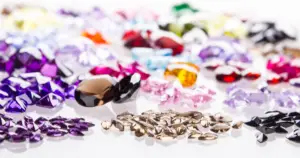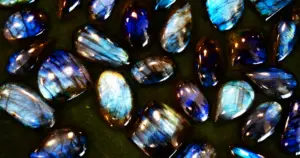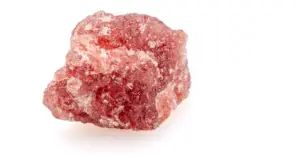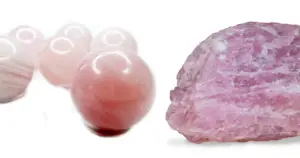How to tell if Citrine is Real or Fake in 7 Easy Ways
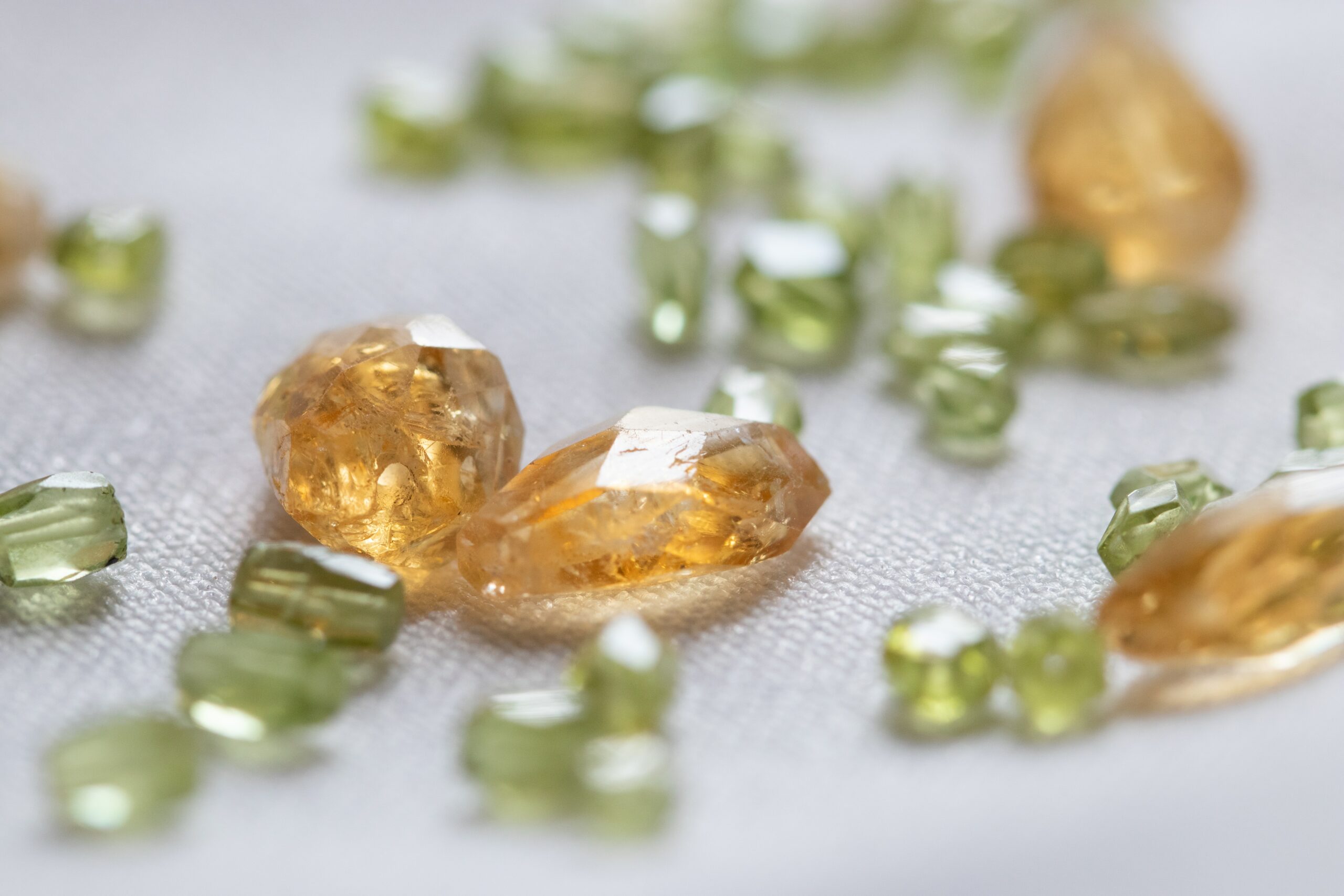
Citrine is derived from the French word for lemon (citron). Citrine is a Yellow Quartz Crystal that emanates positivity, creativity, and light. In this article let us explore if a Citrine is Real or Fake.

Citrine gets its color from trace amounts of iron present in the earth’s mantle during quartz formation. The most readily available, cheaper varieties of Citrine in the market are not citrines at all. Instead, they are heat-treated amethysts or smoky quartz.
Amethysts that are heat-treated to appear citrine yellow are not necessarily fake since they are both varieties of quartz. Many collectors even prefer the heat-treated type for its fiery, vibrant colors and its metaphysical properties of grandiosity and abundance.
Table of Contents
What are the Benefits of Citrine?
1. From the Ancient Romans, who made lavish ornaments, to the Art Deco era, Citrine owes its continued popularity to its association with joy, grace, and the positive energy it endows on its users.
2. This crystal is of abundance and manifestation, attracting prosperity and wealth, and is often referred to as the Merchants or Success Stone. It is also popular with artists for stimulating creativity and imagination.
3. Due to the distinct coloration of its quartz, Citrine is one of the most popular yellow gemstones. The deeper the yellow, the greater its market value. Mining alone, however, yields very little Citrine, which makes this scarce gem prone to synthetic production.
But some collectors would rather not have their crystals interfered with and prefer natural crystals as the earth intended them to be.
If you are looking for a naturally occurring citrine or already own one and suspect its originality, here is a list of things to keep in mind about the crystal:
How are synthetically heat-treated citrines obtained?
- It all begins with pale-colored amethyst clusters, which are placed in industrial ovens or kilns and heated up to a temperature of at least 482 degrees Celsius.
When quartz is heated, iron impurities such as those contained in Amethyst are reduced, resulting in lesser amounts of violet and a transformation of the color of the crystal to a bright amber.
- Heat treating Amethyst returns a very deeply rich, almost rusty brown to yellow sawdust variety of coloration, while Smoky Quartz comes out with a much lighter yellow color.
Watch this video to know more about Citrine:
How to Identify if a Citrine is Real or Fake?
Observe the Pattern and Distribution of Color
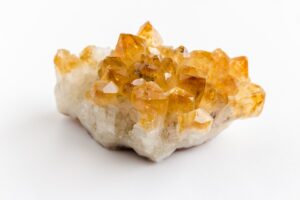
The cut specimens of citrine gemstones occur in all shades, from a pale straw-yellow to the richest orange hue, often with a brown tinge.
Unfortunately, uncut models of minerals of equal quality in color are rare in mineralogical collections. Naturally occurring pale yellow Citrine is derived from many localities, but the best and deeper colored varieties are said to be found in Brazil.
While buying a Citrine, begin by visually examining your crystal from top to bottom and side to side. Observe the coloration and its distribution on your crystal.
If you look at the terminations on the crystal in the adjacent image, especially from the side, you can see that the yellow color is concentrated in the tips of these termination points, while the base essentially appears white. Again, these properties are closer to Amethyst than Citrine, which is more uniformly colored throughout.
Common signs to tell if a singular citrine crystal pulled from a cluster is industrially heated:
The yellow color is
- a bright pearly amber
- It is most concentrated at the tips of the crystal
- is whiter at the base
Naturally occurring citrine bears :
- a more uniform color all over the crystal
- there is no white at the base
- The color is also not very intensely bright: it appears in paler yellow, olive green formations
Scrutinize the Shape and Size of Individual Crystals

Another easy tell is the shape and formation of Citrine you are being sold. If your so-called Citrine appears in a geode or cluster formation like in the adjacent picture, it is likely an industrially heated amethyst.
Amethyst most commonly grows in a compact cluster formation on a matrix rock. Citrine, on the other hand, rarely ever grows in clusters.
Consequently, when pulled from a matrix, an amethyst has more of a dog-tooth shape, while a natural citrine has long parallel sides similar to that of clear quartz.
Observe and contrast the toothy pointed shape of a singular Amethyst crystal on the left and the hexagonal pyramid shape of the Citrine crystal on the right.
Check for Crystal Transparency

Naturally occurring Citrine typically varies from transparent to translucent with reasonably good clarity across the stone.
Since low-quality Amethyst is used for heat treatment, you will find that synthetic citrines aren’t usually as clear.
In addition, the differential concentration of color on a heat-treated Citrine may cause its opacity to vary across the crystal surface, which is uncharacteristic of citrines that are heated under earth’s pressure.
Check for Loss of Color over Time
This is for those who suspect the originality of a citrine crystal they have owned for a while.
If your Citrine is losing color and shows traces of a purple hue that did not exist earlier, you can be sure that the Citrine is synthetically produced. This is because the synthetic heat treatment of amethysts is a reversible process and often reverses itself over time.
Once an amethyst is heated and transformed into Citrine, giving it the yellow color, it can be irradiated and turned back into Amethyst, and then you can heat it again and turn it into Citrine again.
Check for Hardness
Citrine has a hardness of 7 on the Mohs scale.
A quick way to ward off fakes such as glass or plastic is to run a scratch test on any mineral ranked lower on the Mohs scale, such as glass.
If your crystal scratches a glass surface, then you can be assured of it at least being quartz.
Observe how the Crystal Responds to Light
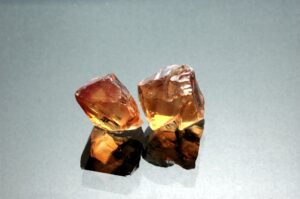
Citrine may resemble other commonly occurring yellow stones, like fluorite and Amber, like a cut gemstone with hardly any inclusions.
One way to tell if a citrine is real and distinct from other resembling materials is how the crystal surface looks when it reflects light.
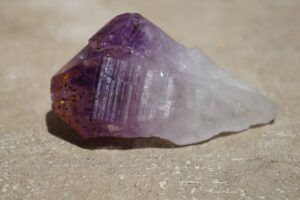
- Citrine has a vitreous luster, which means that the surface appears glassy when in contact with light.
- Its surface typically does not produce any splitting of white light into rainbow formations like some cheaper versions of yellow prismatic glass or yellow plastic might.
- Citrine’s distinctive vitreous luster can also help you differentiate it from the resinous seeming Amber, another popular yellow stone.
When identifying Citrine as distinct from Amber, turn it around in your hand and observe how it interacts with the light around you. Since Amber is fossilized plant resin, it may appear more glossy honey-like (left, below) against Citrine’s glassy finish. (right, down)
Observe the Metaphysical Differences between Natural and Industrially made Citrine
Metaphysically too, there are differences between a natural and a synthetic citrine. While natural Citrine is said to work restoratively, a heated treated amethyst that turns yellow carries in its energies of turmoil and unrest.
For some, it may offer revival, while for others, a synthetic citrine may aggravate intensity and anger.
If you can hold out a Citrine in your palms, the most fundamental way to identify if it is the crystal for you is to register its metaphysical properties.
- Allow for the energies of the crystal to run through you. Set an intention before buying the crystal.
- Let your encounter with the Citrine be invitational rather than consumptive.
Final Comments
In this article, we have covered the several ways in which synthetic Citrine is produced and made available through mechanical reproduction.
Physically, you can learn to differentiate between a citrine from the earth and an industrially produced one by observing the shape, the crystallography, and the color.
Citrine crystals are rendered their scintillating yellow by iron in the earth’s mantle.
While we have learned to imitate and simulate the heat and pressure conditions that lead to the production of these glorious yellow stones, we cannot possibly mimic the cumulative effects of time’s repeated whetting, which endows Citrine with its capacity to bring calm and offer conditions for clear-headed reflection.
Due to the inundation of synthetic citrine crystals in the market, we must acquire the tools for identifying Citrine in its natural formations.
Sellers often build myths of origin around crystals to make them lucrative products for consumption and status. Unfortunately, if you are looking for a natural citrine, you may not benefit much from such mythography.
For example, if the crystal being sold to you is said to be mined from Brazil, remember that most Amethyst used in heat treatments also comes from Brazil, as does most of the richest supplies of natural Citrine.
Such situations teach us to trust the seance of our bodies with the crystal more than we trust the myths of grandiosity built to mystify our relationship with the crystal.
What are some outrageous myths of origin you have heard about Citrine? Let us know.
